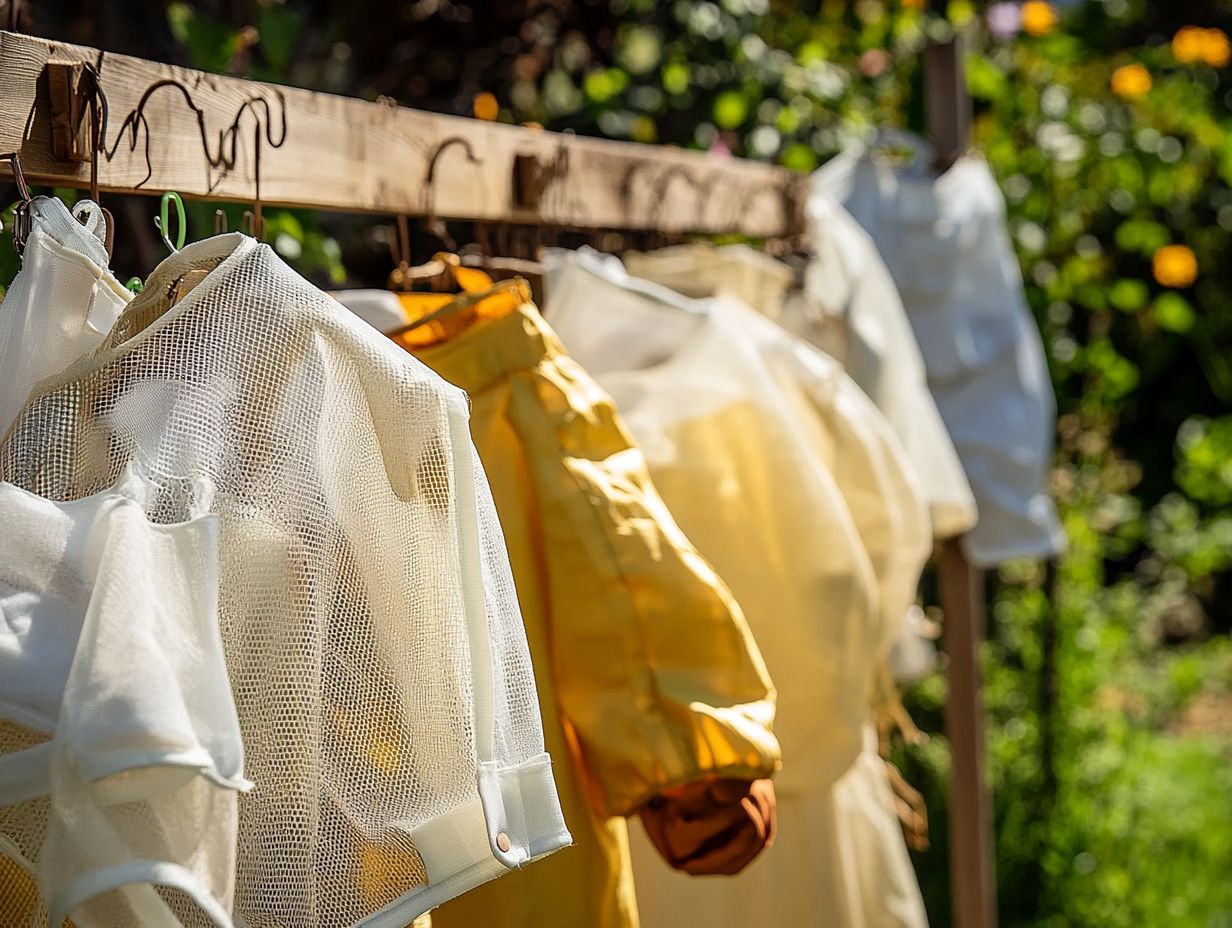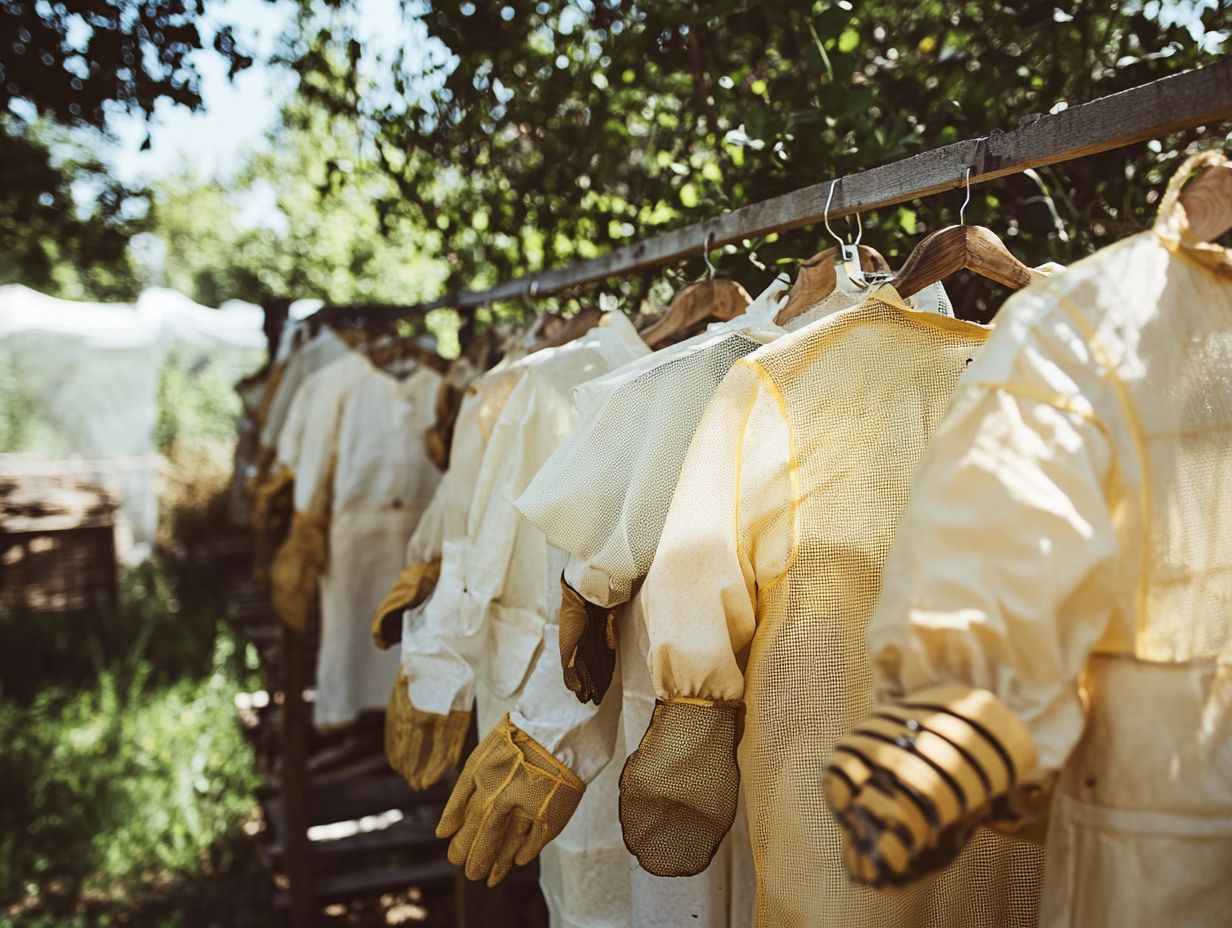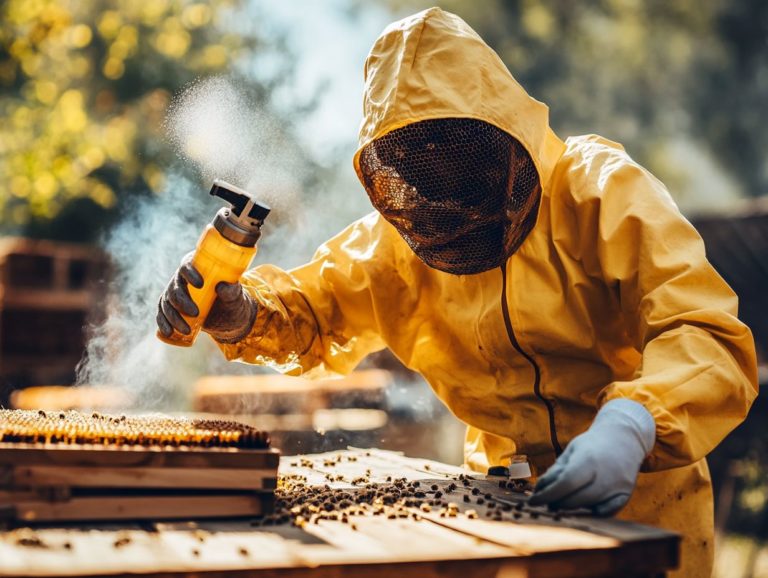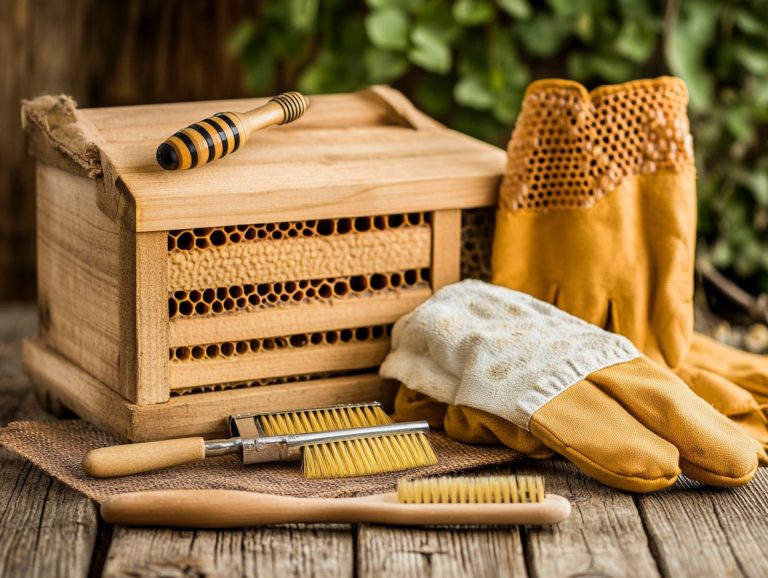Choosing the Right Beekeeping Suit for Beginners
Beekeeping is a rewarding and fascinating hobby that beautifully connects you with nature while supporting vital ecosystems. Join the buzzing community of beekeepers today! Discover the amazing world of bees and how you can make a difference!
However, it also presents its own set of challenges, one of which is ensuring your safety while handling bees. That s where a proper bee suit comes into play. Essential for both beginners and seasoned apiarists, it offers crucial bee protection against stings, allowing you to enjoy the experience without unnecessary worry.
This guide delves into the world of beekeeping, emphasizing the importance of a quality suit, exploring the various types available, and providing tips for choosing and caring for your protective gear. Whether you’re just starting your beekeeping journey or seeking to upgrade your equipment, this guide has everything you need to ensure your success.
Contents
- Key Takeaways:
- What is Beekeeping?
- Why is a Beekeeping Suit Necessary?
- What are the Different Types of Beekeeping Suits?
- What are the Factors to Consider When Choosing a Beekeeping Suit?
- How to Properly Wear a Beekeeping Suit?
- What are Some Additional Protective Gear Needed for Beekeeping?
- Where to Purchase a Beekeeping Suit?
- How to Properly Care for and Maintain a Beekeeping Suit?
- Frequently Asked Questions
- What is the most important factor to consider when choosing a beekeeping suit for beginners?
- What type of beekeeping suit is recommended for beginners?
- What are the different materials used in beekeeping suits?
- Should I choose a ventilated or non-ventilated beekeeping suit?
- Are there any specific features I should look for in a beekeeping suit for beginners?
- Is it necessary to invest in a high-quality beekeeping suit?
Key Takeaways:

- Choose a beekeeping suit that provides the necessary protection and comfort for beginners, considering factors such as material, size, ventilation, and durability.
- Properly wear and maintain the chosen beekeeping suit to ensure maximum protection while beekeeping.
- You also need beekeeping gloves, boots, and a hat with a veil for complete protection.
What is Beekeeping?
Beekeeping is the art of nurturing bee colonies, typically within beehives, and it revolves around the care of honey bees essential creatures for pollination and honey production.
As a beekeeper, whether you re stepping into this world for the first time or you re a seasoned apiary manager, you engage with an array of specialized beekeeping tools and equipment designed to promote the health and productivity of your bees.
Beekeeping is not just rewarding; it also supports local ecosystems and gives you delicious honey, beeswax, and more! For female beekeepers, the right protective clothing is essential for comfort and safety.
Why is a Beekeeping Suit Necessary?
A beekeeping suit is an essential item of protective clothing. It reduces the risk of bee stings and enhances overall safety.
Beekeeping safety starts with choosing the right bee suit fitting and ensuring proper maintenance of your suit. Whether you re just starting out in beginners beekeeping or you’ve mastered the craft, donning a beekeeping suit ensures you are well-protected while tending to your colonies in the apiary.
These suits are meticulously designed to create a reliable barrier against bee stings, giving you the confidence and comfort to manage your hives effectively.
What are the Different Types of Beekeeping Suits?
Beekeeping suits come in a delightful variety, each tailored to meet the unique needs and preferences of beekeepers like yourself.
If you seek complete coverage, full suits are your best bet. However, if you prefer a more relaxed approach, half suits offer greater mobility and comfort.
For those sweltering days, ventilated suits are designed to keep you cool during those hot days while working, made from lightweight and breathable material.
Alternatively, beekeeping jackets and smocks strike a perfect balance between essential protection and flexibility. Beekeeping jackets often come with a hood and veil for added protection. Grasping the nuances of these different styles and features is vital for ensuring your safety and comfort while tending to your bees.
1. Full Body Suit
When you step into the bee yard, your gear is your first line of defense! A full body suit is the ultimate beekeeping armor, designed to give you maximum protection against pesky bee stings. This suit covers your entire body arms, legs, and torso making it essential for beekeepers who work closely with hives or handle feisty bee colonies.
Made from durable materials, full suits feature extra strong seams and protective mesh veils, ensuring your safety and comfort as you tend to your buzzing charges. Choosing the right full body suit can greatly improve your beekeeping experience. Lightweight fabric options help you stay cool during sweltering summer days.
Many suits feature elastic cuffs and ankles for a snug fit, keeping curious bees from sneaking in. Plus, various designs include pockets for your tools, adding practicality to your beekeeping endeavors.
You ll find popular options made from cotton, polyester blends, or cotton blend, with some models offering extra UV protection and water resistance. Invest in a beekeeping suit that prioritizes safety while enhancing comfort for those long hours of wear. Don t miss out on the latest features that can make your beekeeping safer and more enjoyable!
2. Jacket and Veil
Beekeeping jackets paired with a veil provide a versatile option for protection without the heft of a full suit. Crafted from lightweight fabric, these jackets grant you greater freedom of movement, making them perfect for a more casual approach to beekeeping.
With options for hoods and veils, such as the fencing veil, round veil, or square veil, these jackets offer essential protection for your head and neck while keeping you cool during hive inspections.
You ll find a range of styles and materials available to cater to your specific preferences and climate. For example, cotton jackets are breathable and easy to clean, while heavier options provide extra durability against abrasions.
When choosing a beekeeping jacket, consider fit, pocket placement for your tools, and whether you prefer elastic cuffs for enhanced protection. The right jacket elevates your comfort and mobility while reducing the risk of bee stings, allowing you to focus on your bees rather than your safety. For added protection, wearing jeans underneath can help shield against stings.
3. Smock and Veil
Smocks offer you a lightweight alternative to traditional beekeeping suits, expertly designed for essential protection while enhancing airflow and comfort, especially in warmer conditions. Pairing a smock with a veil effectively shields you from bee stings while allowing effortless mobility and accessibility, making this combination a favored choice among both hobbyists and professional beekeepers.
You ll find a variety of styles and sizes to cater to diverse needs. Look for options with elasticized cuffs for a snug fit or those featuring full-length zippers for easy wear. The breathable fabric helps regulate temperature, ensuring you stay cool and protected during your beekeeping tasks.
Many models also come with added conveniences, such as bee suit pockets for your tools or reinforced areas for extra durability. When selecting a veil to complement your smock, you can choose from fitted, round, or square options, each providing a barrier against bees while ensuring clear visibility.
Explore our recommended suits now to find the perfect fit for your beekeeping adventures!
4. Coveralls and Veil

Coveralls are great for beekeepers. They offer full-body coverage, flexibility, and ease of movement. Typically crafted from breathable materials, these suits guard against bee stings without sacrificing comfort during long hours in the apiary. When paired with a veil, coveralls provide comprehensive protection, making them an ideal companion for hive handling and interactions with bees. Some suit manufacturers offer specialized designs with additional protective features.
The design of these coveralls often includes elastic cuffs and adjustable waists, enhancing fit and preventing any uninvited guests from joining you inside. These practical elements, combined with lightweight yet durable fabric, allow you to maneuver efficiently without any hindrance.
Customize your coveralls with different veil styles for the perfect fit! This allows you to choose the level of visibility and ventilation that best meets your preferences. This customization elevates your comfort throughout beekeeping and ensures a safer experience by adding an extra layer of protection against unexpected bee encounters.
What are the Factors to Consider When Choosing a Beekeeping Suit?
When selecting a beekeeping suit, several critical factors demand your attention to ensure the best fit, protection, and comfort level while working with your bees.
The choice of material is crucial as it directly influences breathability and your overall comfort during hive inspections. The size and fit of the suit also matter, significantly impacting your mobility. Proper ventilation is essential for keeping you cool, especially in warmer climates.
Evaluate the level of protection the suit provides and its durability. These elements are vital for maintaining your safety during beekeeping activities.
1. Material
The material of your beekeeping suit is pivotal in shaping both your comfort and effectiveness while tending to the hives. You’ll commonly encounter options like soft cotton fabric, durable polyester blends, and lightweight fabrics that promote breathability and ease of movement. Each of these materials brings its own set of benefits, and selecting the right one can dramatically enhance your beekeeping experience. Consider suit features such as zipper closure for added convenience.
For example, cotton suits are wonderfully comfortable in milder conditions, but they might not provide the same sting protection as polyester blends, which are known for their durability. In warmer climates, breathable options become essential, helping you stay cool while working and minimizing the risk of overheating. Conversely, during cooler weather, opting for a beekeeping suit with thermal lining is crucial to ensure you stay warm without compromising mobility.
Understanding the properties of these materials elevates your comfort and plays a significant role in your overall safety during bee management tasks.
2. Size and Fit
Getting the right size and fit for your beekeeping suit is essential for ensuring your comfort and safety while working with hives. A suit that fits poorly can restrict your movement, leading to discomfort and potentially compromising your safety when managing those buzzing bees. Therefore, accurately measuring yourself and selecting a suit that allows for proper mobility is crucial for an effective beekeeping experience.
The right measurements can truly make a difference, helping you avoid situations where your suit is too tight or excessively loose. When comfortable, you can concentrate on the task at hand without the distraction of an ill-fitting suit.
To measure yourself accurately, wear lightweight clothing and use a flexible measuring tape. Pay attention to key areas like your chest, waist, and inseam. Trying on various sizes while bending and stretching will help you find a suit that complements your movements, ultimately enhancing both your comfort and safety while tending to the bees.
Choose your beekeeping suit today to ensure you’re prepared for your next hive inspection!
3. Ventilation
Ventilation is a crucial aspect to consider when selecting a beekeeping suit, especially during warmer weather. It significantly impacts your comfort level. Ventilated suits come equipped with mesh panels or breathable materials that promote airflow and regulate temperature. This allows you to work for extended periods without the discomfort of overheating.
By ensuring adequate ventilation in your suit, you can maintain your focus and efficiency while managing hives. The market offers a variety of ventilation options tailored to different preferences and environmental conditions. Some suits are crafted from lightweight fabrics that wick moisture away, while others feature strategically placed mesh zones designed to enhance airflow without compromising your protection.
These thoughtful design elements not only help you stay cool but also reduce the likelihood of fatigue during long hours in the apiary. Investing in a well-ventilated beekeeping suit can elevate your experience with bees. You ll be able to fully enjoy your passion while prioritizing safety and comfort.
4. Protection Level
The level of protection provided by a beekeeping suit is essential for safeguarding against bee stings. It ensures your safety while tending to your bees. Suits crafted from thicker materials with reinforced seams offer superior coverage. They come with built-in covers for your face and neck, along with gloves that work together to provide comprehensive protection from stings.
Understanding the protection levels is crucial for your safety! This is especially important if you re working with more aggressive bee species or managing larger apiaries. Top suits come with multiple layers that shield you from stings while promoting breathability, helping to alleviate heat stress during those long hours in the field.
When evaluating a beekeeping suit s protective features, pay attention to aspects like fabric density, zipper quality, and overall fit. Remember, any gaps can lead to unwanted encounters with bee stings. Prioritizing these elements can dramatically boost your safety and comfort don’t overlook them!
5. Durability
When selecting a beekeeping suit, durability should be at the forefront of your decision-making process. It directly influences the lifespan and reliability of your protective gear. Opt for high-quality suits made from rugged materials designed to withstand wear and tear while offering the necessary protection during your hive work.
Familiarizing yourself with the maintenance requirements and the reputation of suit manufacturers can aid you in choosing suits that promise longevity and exceptional performance. Several factors play a crucial role in a beekeeping suit’s durability, including the choice of fabric, stitch quality, and reinforcement at stress points.
While breathable materials enhance comfort, they must also be resistant to punctures and abrasions from branches and the edges of hive frames. By adhering to proper care practices such as washing the suit according to the manufacturer’s instructions and storing it away from direct sunlight you can significantly extend its lifespan.
It’s wise to explore options from trusted brands like Mann Lake and Dadant. These manufacturers are known for their unwavering commitment to quality and their ability to create suits that can withstand the rigors of daily use without compromising your safety.
How to Properly Wear a Beekeeping Suit?

Wearing a beekeeping suit correctly is essential for maximizing your safety and comfort while working with bees. Ensure that your suit fits properly with no gaps that could expose your skin to bee stings.
The right gloves are crucial for protecting your hands. Confirm that all components of your suit, including the veil and cuffs, are securely in place for a successful beekeeping experience.
To begin, select a suit that corresponds to your body size, allowing for ease of movement. Once you have the suit on, make sure to zip it up fully and adjust the elastic bands around the cuffs, ankles, and waist for a snug fit, minimizing any openings.
The veil should fit well and not touch your face while providing an unobstructed field of vision. Your gloves should extend past the cuffs of your suit for complete coverage. A quick inspection for any tiny openings will help you avoid unfortunate encounters with bees, fostering a safe and enjoyable beekeeping session.
What are Some Additional Protective Gear Needed for Beekeeping?
Alongside a beekeeping suit, several key pieces of protective gear are essential for your safety when working with bees. Don t forget to gear up with gloves for ultimate protection!
Wear sturdy boots to safeguard your feet during hive inspections. A hat and veil combination is also essential; it protects your face and neck while enhancing your visibility as you manage hives.
Prioritizing this gear will ensure a safer and more enjoyable beekeeping experience.
1. Gloves
Beekeeping gloves are an essential part of your protective gear, crafted to safeguard your hands from bee stings while allowing you the ability to move your hands easily. These gloves come in various materials, including leather, cotton blends, and synthetic options, each offering unique protection and comfort.
Choosing the right pair is vital for ensuring that you can handle your bees with both confidence and efficiency. For instance, leather gloves are robust and provide excellent sting protection, perfect for working with more aggressive bees.
Cotton gloves are lighter and breathable, making them ideal for warmer days, though they may not offer the same sting defense. If you value flexibility and durability, synthetic gloves could be your best bet, often featuring reinforced seams and enhanced grip.
Think about your specific beekeeping environment whether you’re managing hives in humid conditions or cooler climates when selecting your gloves. Choosing the right gloves quickly can boost your confidence and efficiency while working with bees.
2. Boots
Sturdy boots are essential for your beekeeping gear, providing vital protection for your feet during hive inspections. Look for boots that are durable and waterproof, allowing you to traverse various terrains without worry.
For wet or muddy conditions, waterproof rubber boots are ideal; they keep your feet dry and are easy to clean. On the other hand, tall leather boots provide robust protection and are perfect for dry, thorny areas, offering extra defense against stings.
Ensure your boots have non-slip soles to help prevent slipping on uneven ground. As you evaluate your working conditions, consider these features to find the perfect pair that balances safety, comfort, and durability in your beekeeping endeavors.
3. Hat and Veil
A hat and veil combination is an essential protective layer for you as a beekeeper. It expertly shields your face and neck from bee stings while ensuring a clear field of vision. The veil, typically crafted from breathable mesh material, allows air to flow freely while keeping those buzzing bees at bay. Wearing a hat with a veil significantly enhances your overall safety and comfort during beekeeping activities. This setup makes it easier to manage hives without any distractions.
Wearing gloves adds an extra layer of protection to your beekeeping equipment. This protective gear not only prioritizes safety but also offers various styles to choose from, including wide-brimmed hats and fitted caps. These options allow you to select what best suits your needs. Different veils offer different levels of effectiveness, with options like detachable veils or those equipped with elastic neckbands providing varying levels of coverage and comfort. Choosing the right bee suit style and design can also play a crucial role in your overall protection and comfort level.
When selecting the right combination, it’s important to consider your local climate, the level of bee activity, and your personal comfort. This ensures an enjoyable beekeeping experience. Trying on different styles before making a decision can help you discover the perfect balance between protection and mobility, which is vital for anyone working among these fascinating insects. Beekeeping jackets and half suits may offer varying degrees of coverage and flexibility.
Where to Purchase a Beekeeping Suit?
When you’re in the market for a beekeeping suit, you can explore multiple avenues, including specialized beekeeping supply stores, online retailers, and direct purchases from suit manufacturers. As you seek the right bee suit, it’s crucial to assess the reputation of the seller and the quality of the equipment they offer. Choosing a reliable source ensures that you can invest confidently in your personal safety. Remember, the bee suit fitting should also be considered to ensure maximum protection and comfort.
Each purchasing option brings its own set of pros and cons. For instance, specialized stores often provide personalized advice and support, but their selection may be somewhat limited. Online retailers typically boast expansive inventories and competitive pricing. However, you miss out on the tactile experience of trying on the suits for the perfect fit. Purchasing directly from manufacturers might lead you to high-quality, custom-fit options, but be prepared for longer wait times for delivery.
No matter which route you decide to take, make it a priority to select suits made from durable materials that provide ample ventilation. Brands like Mann Lake and Smoky Mountain are well-regarded in the industry, catering to various needs and budgets. They make excellent starting points for your search. Be sure to also consider bee suit colors, as lighter colors can help keep you cool while beekeeping.
How to Properly Care for and Maintain a Beekeeping Suit?
Proper care and maintenance of your beekeeping suit are essential to ensuring its longevity and effectiveness as protective gear. Regular cleaning, in accordance with the manufacturer’s guidelines, will help preserve the suit’s integrity and functionality. Proper storage will shield it from environmental damage. By understanding your suit’s maintenance needs, you’ll ultimately enhance its durability and performance. Suit maintenance involves regular inspections and cleaning to ensure they remain in top condition.
When you implement a thoughtful cleaning routine, you can significantly reduce the risk of contamination. This ensures that any residual beeswax or propolis, a resinous substance made by bees, doesn t compromise the materials. After each use, a quick rinse or spot cleaning can thwart the buildup of dirt and debris. A thorough wash every few months will eliminate any stubborn residues. Wearing jeans under your beekeeping suit can also help prevent stains and make cleaning easier.
Storing your suit in a cool, dry place, away from direct sunlight, is crucial. Prolonged exposure to UV light can degrade the fabric over time. Regular inspections will help you spot any signs of wear and tear early. This allows for timely repairs, which are vital for maintaining the suit’s protective qualities. Utilizing queen cages can also assist in managing the bees safely during inspections.
Start shopping for your beekeeping suit today to ensure a safe and enjoyable experience!
Frequently Asked Questions

What is the most important factor to consider when choosing a beekeeping suit for beginners?
The most important factor to consider when choosing a beekeeping suit for beginners is protection. Bee stings can be painful and even dangerous, so it is crucial to choose a suit that offers the best protection against stings.
What type of beekeeping suit is recommended for beginners?
Beginners beekeeping can be daunting, and choosing the right suit is essential. For beginners, a full-body beekeeping suit that covers from head to toe is highly recommended. This type of suit provides the most coverage and protection from bee stings.
What are the different materials used in beekeeping suits?
Beekeeping suits are typically made from cotton, polyester, or a blend of both. Some suits also have added layers of mesh or other materials for extra protection against stings. Ventilated suits made from lightweight fabric and breathable material are also popular choices for warmer climates.
Should I choose a ventilated or non-ventilated beekeeping suit?
Your choice depends on what you prefer and the weather in your area. Ventilated suits allow for better airflow and can be more comfortable in hot weather. Non-ventilated suits provide better protection in cooler weather.
Are there any specific features I should look for in a beekeeping suit for beginners?
In addition to full coverage and protection, beginners should look for suits with stretchy cuffs and ankles, as well as a zippered or elasticized veil for easy removal and added security against bee stings. Zipper closure and bee suit pockets are other useful features for added convenience and safety.
Is it necessary to invest in a high-quality beekeeping suit?
Absolutely! Investing in a good beekeeping suit is essential for every beginner. A good suit will provide the best protection and will last longer, ultimately saving you money in the long run. It is not worth risking your safety and comfort with a cheap, low-quality suit. Protective gloves and proper beekeeping equipment are also essential for safe beekeeping practices.






